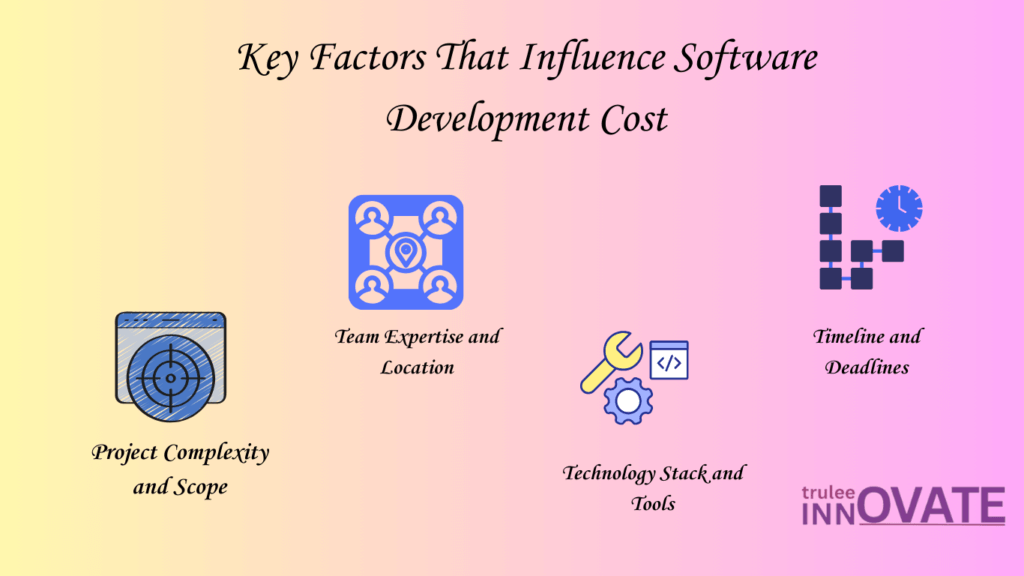Introduction to Software Development Cost
The digital age has made custom software development an essential aspect of modern businesses. However, understanding the software development cost isn’t always straightforward. Costs vary significantly depending on the project’s scope, the development team’s expertise, and the technology stack employed.
Whether you’re developing a mobile app, a CRM system, or an e-commerce platform, software development is an investment—one that requires careful planning to yield a positive return. Without a clear understanding of how costs are structured and what factors contribute to them, businesses risk overspending or underfunding their projects, leading to failure or unmet goals.
This blog provides a comprehensive guide to understanding the true cost of software development and how businesses can navigate the process efficiently.
Key Factors That Influence Software Development Cost
- Project Complexity and Scope
- Simple Projects: Examples include basic mobile apps with limited features like a calculator, task manager, or single-page website. Such projects cost $10,000–$50,000 due to their limited functionalities.
- Complex Projects: Complex solutions like enterprise-level software, AI-driven analytics platforms, or multi-region e-commerce platforms can cost upwards of $100,000–$500,000. Complexity is driven by the number of features, integrations, and scalability requirements.
- Technology Stack and Tools
- Open-Source vs. Proprietary Software: Using open-source tools like Laravel or React can reduce costs, while proprietary tools with licensing fees (e.g., .NET framework) can increase the overall budget.
- Emerging Technologies: Projects requiring AI, blockchain, or AR/VR often involve additional costs for specialized resources and tools.
- Team Expertise and Location
- In-House Teams: Building an in-house development team in countries like the U.S. or the U.K. can cost $100–$200/hour per developer.
- Outsourcing: Outsourcing to regions like India, Eastern Europe, or Southeast Asia offers skilled developers at $20–$50/hour, significantly reducing costs without compromising quality.
- Timeline and Deadlines
Projects with shorter timelines often require larger teams or overtime work, increasing the overall cost. Setting realistic deadlines ensures better cost control.

Stages of Software Development and Their Cost Breakdown
- Planning and Requirement Analysis
- This foundational stage involves identifying business goals, user needs, and project constraints. It may include stakeholder interviews, competitor analysis, and creating a product backlog.
- Cost: 10–15% of the total budget.
- Deliverables: Requirement documents, project scope, and initial wireframes.
- Design and Prototyping
- The focus is on creating an intuitive user interface (UI) and user experience (UX). Tools like Figma or Adobe XD are used to design prototypes that reflect the final product.
- Cost: $5,000–$50,000 depending on project size.
- Deliverables: Mockups, wireframes, and interactive prototypes.
- Development and Testing
- This stage involves coding, integrating APIs, and conducting tests for performance, security, and functionality.
- Development consumes 40–60% of the budget, while testing accounts for 10–15%.
- Deliverables: Source code, tested modules, and deployment-ready software.
- Deployment and Maintenance
- Deploying software to servers or app stores involves additional costs, including server hosting and domain registration. Maintenance for bug fixes, updates, and feature enhancements incurs recurring expenses.
- Cost: 20–30% of the initial development cost annually.
Hidden Costs in Software Development
- Upgrades and Scalability
- Businesses often underestimate the cost of scaling their software. A solution that supports 1,000 users may need significant upgrades to accommodate 100,000 users.
- Upgrades can include database optimization, additional server capacity, and re-architecting codebases.
- Training and Onboarding for Users
- Custom software often requires employee training. This involves creating training modules, onboarding guides, and sometimes hiring trainers. Training costs can add 10–20% to the total budget.
- Third-Party Integrations and Licensing Fees
- Integrations like payment gateways, cloud storage, or analytics tools often come with recurring fees. For example, using Stripe for payments involves transaction fees, while AWS cloud services incur monthly charges based on usage.
Comparing In-House Development vs. Outsourcing
- In-House Development
- Advantages: Full control over the project, better communication, and alignment with company goals.
- Disadvantages: High recruitment costs, infrastructure expenses, and limited scalability for new projects.
- Outsourcing
- Advantages: Access to global talent, reduced costs, and faster project execution.
- Disadvantages: Potential language or time-zone barriers and limited direct oversight.
Common Mistakes That Increase Software Development Cost
- Lack of Proper Planning
Failing to define project goals and requirements leads to misalignment and frequent revisions, increasing costs. - Frequent Changes in Requirements
Scope creep occurs when additional features or changes are introduced mid-project without reassessing the budget. - Poor Communication
Miscommunication between stakeholders and developers can result in rework, extending timelines and inflating costs.
How to Optimize Your Software Development Cost
- Clear Goal Setting and Documentation
- Define your objectives and document requirements clearly. Using tools like Jira or Trello can help streamline this process.
- Leveraging Agile Methodologies
- Agile frameworks like Scrum or Kanban allow for iterative development, enabling better cost control and adaptability.
- Choosing the Right Development Partner
- Evaluate potential partners based on experience, portfolio, client reviews, and pricing transparency.
Real-Life Examples of Software Development Cost
- Startup Case Study
A startup developed a food delivery app for $70,000. The bulk of the cost went toward development, while UI/UX design accounted for 20%. - Enterprise Example
A multinational corporation spent $500,000 on a custom ERP system. Maintenance costs were $50,000 annually to keep the system updated.
Future Trends Affecting Software Development Cost
- AI and Automation in Development
- AI-driven tools like GitHub Copilot reduce coding time, lowering labor costs.
- Low-Code and No-Code Platforms
- These platforms enable businesses to build software faster at a fraction of traditional development costs.
- Remote Development Teams
- The rise of global, remote teams allows companies to leverage affordable talent from different regions.
Conclusion: Making Informed Decisions
The software development cost is influenced by numerous factors, from project complexity to hidden expenses. By understanding these aspects, businesses can make informed decisions, budget effectively, and achieve desired outcomes without overspending.


